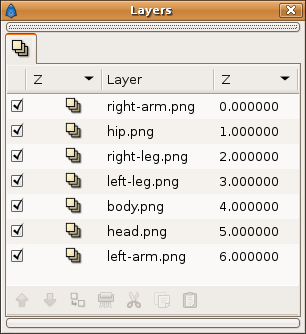Difference between revisions of "Doc talk:Cut-out Animation"
From Synfig Studio :: Documentation
m |
(Reply to dooglus) |
||
| Line 2: | Line 2: | ||
http://dooglus.rincevent.net/synfig/cutoutsample2.sifz shows an example of what I'm talking about. It renders in 41s, compared to 68s for the original, around 33% faster. -- [[User:Dooglus|dooglus]] 04:00, 18 December 2007 (EST) | http://dooglus.rincevent.net/synfig/cutoutsample2.sifz shows an example of what I'm talking about. It renders in 41s, compared to 68s for the original, around 33% faster. -- [[User:Dooglus|dooglus]] 04:00, 18 December 2007 (EST) | ||
| + | |||
| + | : That's valid only if the nested image layers are also composed in the same Z order. But if the image layers are composed in different Z order but the ortiation hieracrchy is different, then the set-up I've done is the only one that allow a general character set-up. If you look to the initial set-up: | ||
| + | |||
| + | [[Image:Layers-Images.png]] | ||
| + | |||
| + | : you can see that the body layer must be placed behind the hip, the left, the right leg, and the rigth arm layers to compose properly the character. How can I perform a body rotation (what means a head, left arm and rigt arm rotation too) without rotate the hip or the legs in a nested hierarchy? (NOTE: I've replied your comments without watching your sample. Maybe I'm wrong.)--[[User:Genete|Genete]] 10:36, 18 December 2007 (EST) | ||
Revision as of 17:36, 18 December 2007
Why are you making multiple copies of the rotation layers? This technique will work exactly the same if you nest the 'children' limbs inside the parent's encapsulation. Then you need only a single rotation layer for each joint which should make things render faster, and make the document simpler to examine. -- dooglus 03:03, 18 December 2007 (EST)
http://dooglus.rincevent.net/synfig/cutoutsample2.sifz shows an example of what I'm talking about. It renders in 41s, compared to 68s for the original, around 33% faster. -- dooglus 04:00, 18 December 2007 (EST)
- That's valid only if the nested image layers are also composed in the same Z order. But if the image layers are composed in different Z order but the ortiation hieracrchy is different, then the set-up I've done is the only one that allow a general character set-up. If you look to the initial set-up:
- you can see that the body layer must be placed behind the hip, the left, the right leg, and the rigth arm layers to compose properly the character. How can I perform a body rotation (what means a head, left arm and rigt arm rotation too) without rotate the hip or the legs in a nested hierarchy? (NOTE: I've replied your comments without watching your sample. Maybe I'm wrong.)--Genete 10:36, 18 December 2007 (EST)
